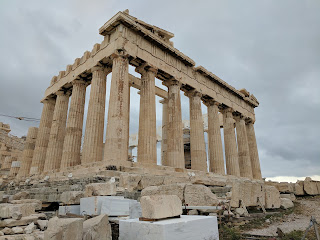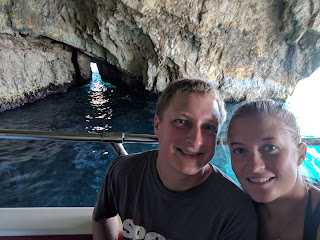We started our last day in Egypt by going to the Salah el Din Citadel of Cairo. It was built in 1176 to protect Cairo from the Crusaders and was used as the seat of the king and government in Egypt for many centuries and dynasties. Inside the citadel we visited two mosques. The first is the older of the two and was built in the 1300s. It had a large green dome and it's called Mosque of El Nasser Mohamed. The second took 18 years to build starting in 1818 and is referred to as the Great Alabaster Mosque of Mohamed Ali Pasha. It houses the tomb of Mohamed Ali. It's a very beautiful mosque and still used today. The whole citadel is in a beautiful area overlooking the city and you can also see the pyramids in the distance.
Our next stop is known as the Coptic Cairo area. It's a big religious area with lots of churches and a synagogue. It's also the location of the Cavern Church (aka Abu Serra Church). It's a very beautiful church, and more importantly it's built over the cavern where the Holy Family stayed when they were fleeing Israel where the Roman Empire was persecuting babies. It's believed that they stayed in the cavern for 3 months when Jesus was a baby. How amazing is that?! We were able to go down into the cavern, where we could see part of the original floor and the nook where they believe the baby Jesus slept. It was pretty moving to be there.
We also visited the Hanging Church in that area as well, which was built over a Roman gatehouse. Yasmine told us that when they started building the church they didn't know it was there but then they found it buried so they just built the church right over, which is why it's called "hanging". We were able to go in the church and then look down and see the gate below us. It's one of the oldest churches in Egypt and was built in the 3rd century.
Then we left Coptic Cairo and made a brief visit to the Egyptian Museum so we could check out the museum's exhibit of King Tutankhamen. His tomb was discovered in 1922 nearly intact and many of the artifacts recovered from his extensive tomb are on display in the museum. He became pharoah at 8 years old and died when he was 19. His tomb was unusually small for a pharoah, which indicates he may have died unexpectedly before a grander tomb could be completed. So he was possibly buried in a tomb intended for someone else in order to bury him within the customary 70 days after death. Although his tomb was small it was still very lavish including a solid gold coffin, face mask, thrones, sandals, food, and fresh linen. King Tut is probably the world's best known pharoah largely because his tomb is among the best preserved and therefore his image and artifacts are the most exhibited.
We also walked around the rest of the museum a bit. It has a ton of very old statues and stones with hieroglyphics. Everything was very interesting but it's hard to take everything in.
After the museum we headed to the market where we got some falafel for lunch. Then we walked through part of the Cairo Bazaar just to get a feel for it and look at some of the souvenirs. We didn't buy anything there. We thought we would be hassled by the street vendors but again, we really weren't bothered. Occasionally they would ask as we were walking by if we wanted to buy anything and we would politely decline and that would be the end of it. No big deal. We also walked along "el Moez" street which is 1000 years old and is lined with unique Islamic Buildings.
Another great day with Egypt Tailor Made Tours! Our guide, Yasmine, and driver, Sayed were both very knowledgeable and helpful as always!
I finally published my recap for our time in
Southern Africa so check it out!
We have to check out of our hotel before midnight tonight in order to catch our 3am flight. Yuck. :( But don't feel too bad for us because we're going to Greece!



























































